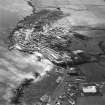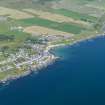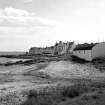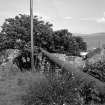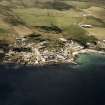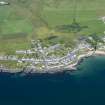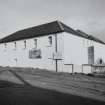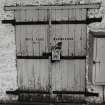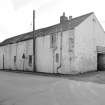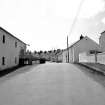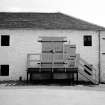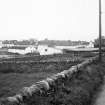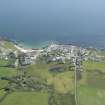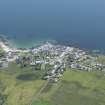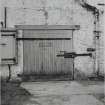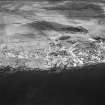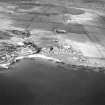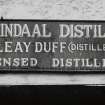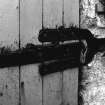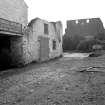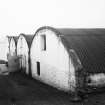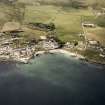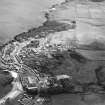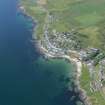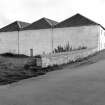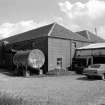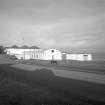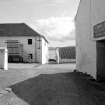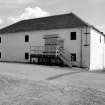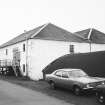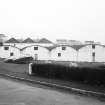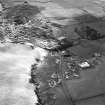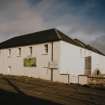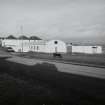Islay, Port Charlotte, Lochindaal Distillery, Bonded Warehouses
Distillery (19th Century) (1829), Warehouse(S) (19th Century)
Site Name Islay, Port Charlotte, Lochindaal Distillery, Bonded Warehouses
Classification Distillery (19th Century) (1829), Warehouse(S) (19th Century)
Alternative Name(s) Loch Indaal; Youth Hostel
Canmore ID 37304
Site Number NR25NE 16
NGR NR 25265 58436
NGR Description Centred NR 25265 58436
Datum OSGB36 - NGR
Permalink http://canmore.org.uk/site/37304
- Council Argyll And Bute
- Parish Kilchoman
- Former Region Strathclyde
- Former District Argyll And Bute
- Former County Argyll
NR25NE 16 centred 25265 58436
LOCHINDAAL DISTILLERY (Warehouses Listed Grade B) NR25NE/16 NR 2527 5841
19th century. Industrial 2 blocks. Rubble; larger block with 4 segmental roofs; small with 3 piended slate roofs. Small
windows. Distillery disused since 1930. Other buildings on W. side of road are ruinous.
(Undated) information in NMRS.
(Location cited as NR 251 584). Lochindaal Distillery, Port Charlotte, 19th century. This has been closed since 1930 but much survives, including two 1-storey blocks of bonded warehouses, one 3-bay and the other 4-bay. The latter is Belfast-roofed.
J R Hume 1977.
A RCAHMS photographic survey was undertaken, during October 1999, to enhance and augment the existing holdings of the National Monuments Record Scotland.
Visited by RCAHMS (MKO), July 1999
One of two 19th century industrial blocks of bonded warehouses originally to the Lochindaal distillery. Single storey, rubble built walls with segmental Belfast roof, small windows. (Historic Scotland)
A photographic postcard of the Distillery, dated circa 1910, shows a range the single storey warehouses with piended slate roofs, it is possible these buildings were subsquently heighted and the Belfast roofs added at a later date.
Port Charlotte was founded in 1828 by Frederick Campbell of Islay as an agricultural and distillery settlement, named for his mother, Lady Charlotte Campbell (FA Walker). Lochindaal, an Islay Malt whisky distillery, founded in 1829 by Colin Campbell, was developed principally by the Sherriff family. It was acquired in 1929 by The Distillers' Company Ltd, and partly dismantled in that year. The malting range being then used by the Islay Creamery in 1976. (J Hume)
Field Visit (1980)
At the period of survey there were eight active commercial distilleries on Islay, together with the remains of a ninth, that of Lochindaal at Port Charlotte, which was closed and partly dismantled in 1929. The list, in chronological order of foundation, comprises Bowmore (1779; NR309599), Ardbeg (1794; NR414462), Lagavulin (1816; NR404457), Laphroaig (1820; NR387452), Port Ellen (1825; NR358458), Lochindaal (1829; NR251584), Caol Ila (1846; NR429700), Bunnahabhainn (1881; NR420732) and Bruichladdich (1881 ;NR264612) (en.1). Many of these were founded as a result of general legislation enacted between 1816 and 1823, and by the 1830s there were as many as sixteen licensed distilleries on the island, some of which appear to have been small and relatively short-lived concerns. With its ideal local supplies of water, peat and barley, Islay had by that time established a long tradition in the making of pot-still malt whisky on a domestic basis, including much illicit distillation; thus some of the larger businesses such as Laphroaig, Lagavulin and Ardbeg seem to have grown up from farming and smuggling origins, while Port Ellen distillery was converted from a malt mill (en.2). Since the early 1960s they have been extensively modernised, particularly with regard to plant and equipment, and this article presents a summary description only of those early or traditional features that have survived.
All the distilleries were built on the coast for direct access by sea. Those at Port Ellen, and notably Bowmore, are near harbours, and the remainder, apart from Laphroaig, are equipped with piers or jetties. At Laphroaig coal and other supplies were delivered by Clyde 'puffers' and then trans-shipped into small boats, or at low tide into carts, for movement ashore. The whisky was floated out to the ships in casks lashed together and a similar practice was also adopted at Lochindaal (en.3) The most important factor influencing their location, however, was water-supply, which was drawn from the neighbouring uphill lochs, springs and burns. In the case of Bowmore, it became necessary to cut a nine-mile lade in order to tap new sources (en.4), and at Ardbeg an artificial channel links Lochs Iarnan and Uigendail serving the distillery. At Laphroaig and Lagavulin nearby dams were intended to conserve the water-supply in the event of drought.
The principal buildings of a distillery layout are the multi-storeyed malt-barns, the extensive warehouse ranges, and the distillation block itself. They present impressive and picturesque groupings, characterised by the pyramidal pagoda-style roofs of the kilns and in former times, by tall chimney-stacks.
The earlier distilleries evolved piecemeal, and Laphroaig, whose physical development is well documented from 1840 onwards, is typical in its sequence of building-phases which culminated in a complex nucleated layout by about 1900 (en.5). At the later distilleries, such as Bruichladdich and Bunnahabhainn, the main processing units were disposed in a regular courtyard layout (en.6). Bruichladdich has a formal entrance-range incorporating terminal pyramidal roofs, and Bunnahabhainn is almost fortress-like in the treatment of its extensive seaward frontage with central high wall and portal.
The building-materials consist of local rubble and slate, though latterly brickwork was increasingly used, and at Bruichladdich the main frontage and still-house range were built of two-leaf pre-cast concrete blocks, then a fairly new material. The external walls are whitewashed, and internally the floors and roofs of the earlier buildings are framed in timber, supported on cast-iron columns over the wider spans.
The typical malt-barn is of two or three storeys, including a barley-loft for initial storage of the grain, furnished with a loading-door and barley-hoist. The lower or 'malting floors', which are surfaced with quarry-tiles, have restricted head-room and are subdivided into long working-aisles by regular rows of columns. The floors are sparingly lit from the side-walls by small regular-spaced windows fitted with internal wooden shutters for controlling the temperature conditions within. Normally contiguous with the malt-barn, and at the opposite end to the 'steeps' - used for soaking the barley prior to germination - is the kiln for drying the 'green' malt. The kiln averages about 10·7 m square, and at ground level contains a central brick furnace surmounted by a hopper-shaped smoke-funnel whose sheet-metal sides spread outwards to encompass the drying-floor, usually about 4· 3 m above. The earliest surviving malt kiln-barns on Islay, probably dating from the 1850s, are the two opposing ranges at Ardbeg, one of which has a double-kiln arrangement, and that at Port Ellen, which incorporates a masonry elevator tower at the end opposite to the kiln. A later and now disused barn at Lagavulin, which also has a double-kiln arrangement along its s side, retains a fine timber truss-roof and a barley-bogey, and is of special interest for its overhead monorail system for conveying grain in wicker baskets over the malting-floor (en.7). Well-preserved iron steeps survive at Port Ellen and Bruichladdich.
The 'mash-house', 'tun room', and 'still-house' are invariably grouped together under one or more roofs, and contain a complex array of vessels and apparatus. Most of the plant has to be renewed periodically but although the few early features that survive are no older than the 1880s, the major components such as the fermenting vessels and copper stills preserve much of their traditional style and character (en.8). Old-style mash-tuns are to be found at Laphroaig and Bruichladdich, and one of the last riveted stills to survive in Scotland also remains in use at Bruichladdich. Adjoining the still-house, or situated nearby, is the 'filling-store', where the newly-made spirit is put into casks. The spirit receiver at Caol IIa, which is situated in the warehouse, has a capacity of 8,500 gallons and is by far the largest on the island; another good example can be seen at Lagavulin.
The 1823 legislation included provision for the storage of whisky in bond without payment of duty, and warehouses progressively became more numerous and space-consuming. Most are of single-storeyed type, disposed in long contiguous ranges designed for the storage of casks in tiers of four or five, and having earth floors to preserve a moist atmosphere. Attractive examples exist at Port Ellen, dated between 1846 and 1907 (en.9), and also along the shore at the former Lochindaal distillery at Port Charlotte. All are whitewashed and characterised by their barred and louvred windows; they also have stout wooden doors secured with heavy locking-bars and double shrouded padlocks. Occasionally, as at Lagavulin and Bruichladdich, the basements of malt-barns were used for storage and at Ardbeg and Caol IIa the warehouses are multi-storeyed. The three-storeyed building at Caol IIa, which has pilastered brick walls and timber floors slatted to promote air circulation, dates from about 1900 and is the last and most impressive of the traditional-style warehouses to have been erected on Islay.
Ancillary buildings worthy of note include a peat-shed constructed entirely of timber, which stood in the courtyard at Ardbeg until 1979 (en.10), and a cooperage repair-shop at Bunnahabhainn which is still equipped with a fine range of cooper's tools. Suitable offices and living-accommodation for the resident manager also usually formed part of the distillery complex, and living-quarters for the Excise Officer were a statutory requirement. After 1893, a standard house was specified for this purpose (en.11), normally a substantial house of four bedrooms, and examples are to be found at Caol IIa and Laphroaig, dating from about 1896 and 1905respectively. Those at Ardbeg, Bruichladdich, and Port Ellen are semi-detached dwellings, originally designed to accommodate both the Excise Officer and the Distillery Manager.
INSCRIBED STONES
(I) Affixed to the gable of the filling-store at Lagavulin isa slate tombstone roughly wrought, splayed at the foot, and bearing a commemorative inscription to Angus Johnson of Lagavulin, who died in 1820.
(2) Lying in the cask-yard at Port Ellen is a dismantled lintel-stone, 2·3 m in length by 0·46 m in width, bearing within a small rectangular panel the incised inscription, A.K. Mackay & Co/1825.
RCAHMS 1984, visited at various dates in 1980
















































